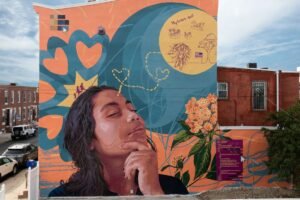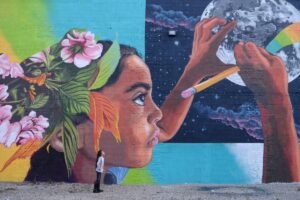February 18, 2016; Boston Globe
After several months of developing and pitching their ideas for art projects that might help to solve civic problems in Boston, three artists have been selected to move their work forward. Each will be embedded in city government as artists-in-residence under a new initiative known as Boston AIR. The program was developed by the city in conjunction with Massachusetts College of Art & Design and largely funded by the National Endowment for the Arts through an “Our Town” grant.
Each of the three artists selected will receive a $20,000 stipend to support a six-month residency, and each project will have a $5,000 budget. Here’s a brief description of the projects:
- “When Women Succeed: The Quilted Path”: Visual and performing artist L’Merchie Frazier, working with the Office of Women’s Advancement and Office of Recovery Services, will lead a multidisciplinary fiber-art project that will include public workshops, poetry and a movable art installation with a “quilted poetry path” that will lead visitors to a nylon “safe house,” representing—and perhaps helping to realize—a “path to recovery” for local women struggling with substance abuse.
- “Time to Listen”: Musician and composer Shaw Pong Liu, working with the Boston Police Department, will tackle gun violence, race and police-community relations through a range of musical interventions. Liu plans to provide live music at funerals, memorials and public vigils to support the families of murder victims. She will also organize songwriting workshops both for police officers and for teens, with the hope of having the two groups collaborate on writing a few new songs.
- “Altering the City: Video Landscape”: Video artist Georgie Friedman, working with the Department of Neighborhood Development and the Parks and Recreation Department, hopes to create “a sort of digital park” through a site-specific video installation that will project images of the natural world onto vacant buildings. As noted by Boston Art Commission director Karen Friedman, this project is also a creative way to invite local residents into conversations about urban planning.
NPQ has previously reported on a number of cities—and rural towns, too—that have invited artists into conversations about municipal planning, civic engagement and change initiatives. Part of the appeal is that artists approach problem-solving in ways that might not occur to those who have become accustomed to working their way through the red tape of a city government.
Sign up for our free newsletters
Subscribe to NPQ's newsletters to have our top stories delivered directly to your inbox.
By signing up, you agree to our privacy policy and terms of use, and to receive messages from NPQ and our partners.
But who are these artists who engage in solving civic problems? A recent article in the New York Times by Daniel Grant explains that many of them are now earning MFAs in a field known as “social practice art,” described by one practitioner as “the opposite of studio practice.” Although there’s nothing new about artists working as change agents or activists, what is relatively new is the growth of social practice as a formal field of study. As Grant explains:
The first academic concentration in the field dates to just 2005, at California College of the Arts in San Francisco. Since then, at least 10 other institutions have established master’s-level degree programs in social practice art (sometimes called community engagement, contextual practice or socially engaged art-making). Many others have added classes, minors, concentrations and certificate programs.
The field is underpinned by a belief in “art as a social good,” and offers a different kind of a career track for artists, with grants and stipends being made available through many different funding sources. But social practice art also requires a different set of skills—in addition to art-making, social art practitioners must know how to collaborate, to facilitate sometimes-difficult conversations, to negotiate, to make public presentations, to advocate, to resolve conflicts, and to work with many different types of people. While these skills may make an artist more marketable, Grant notes that earning that specialized MFA can be an expensive proposition. Which suggests that like most artists, those who take up social practice are not really in it for the money.—Eileen Cunniffe











